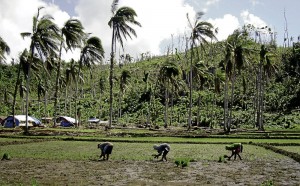
FARMERS in Baganga, Davao Oriental, start planting palay a month after Typhoon “Pablo” devastated their town. Nico Alconaba/Inquirer Mindanao
CATEEL, Davao Oriental—The provincial government of Davao Oriental and the World Food Program (WFP) on Thursday started briefing farmers on the cash-for-work program with an initial target of 800 hectares of rice lands in Cateel, Baganga and Boston municipalities.
Under the program, a farmer could work for 10 days on 1 hectare of rice farm and get P226 per day, or 75 percent of the authorized minimum daily wage set by the Regional Tripartite Wage Regulatory Board, said Sharon Andrea Lumpias, Cash and Voucher Officer of WFP.
Lumpias said the government and WFP would set out a registration for the cash-for-work beneficiaries next week.
Farmers are to be paid from the $400,000 funds contributed by donor countries. Lumpias said USAID has also committed $800,000 for the cash-for-work activities.
Farmer-beneficiaries have welcomed the program but have questions on the process, including limiting the area for tilling to only 1 hectare. Each farmer is allowed to register only once for the program.
Resident Edwin Berha said he used to hire farmers to plant rice on his 3.8-hectare farm at P5,000 under the “pakyaw” (contract) system. Several workers could finish the job for only three to six hours and serve another area the next day.
He proposed that farmers be allowed to work on the same farm and the owner pay for the work on the remaining areas.
“If the government really wants to help the farmers, why not spend for farm inputs such as fertilizers?” he said.
He also questioned the payment. Before Typhoon “Pablo,” Juanito Patac worked on the farm along with five to 10 other workers and each of them got P400 for six hours of planting on 3-5 hectares of rice farm. They then work on another farm the next day.
Patac was also not keen on the one-time registration.
Elsa Basingan, who attended the briefing, said she was fine with the program but it would be useless if the government would not repair the steel gate of the dam providing irrigation to the farms.
Basingan, who owns 1.8 hectares of rice land, said, “with or without the money, we will really work hard but the government should repair the irrigation system because that is important.”
Municipal Rice Coordinator Francis Albarracin said the steel gate of the dam was damaged during the typhoon. This was desilted and cleared of debris days after Pablo but the heavy rain the past weeks in Baganga aggravated the siltation at the dam’s steel gate, blocking the flow of water.
“This problem should be raised to the National Irrigation Authority,” he said.
The UN Office for Coordination of Humanitarian Affairs, through its Food, Shelter and Livelihood cluster, has identified the cash-for-work activities, particularly the restoration of agriculture-based livelihood as one of the immediate ways to ensure adequate food consumption and income support to allow people to move on to the recovery phase.
As of Jan. 31, the total area damaged by Pablo is 95,823 ha, with Compostela Valley having the biggest area destroyed or damaged at 51,773 ha, Davao Oriental with 17,700 ha and Davao del Norte, 26,350 ha. Ayan C. Mellejor, Inquirer Mindanao